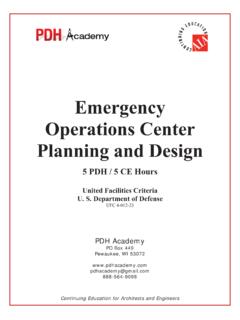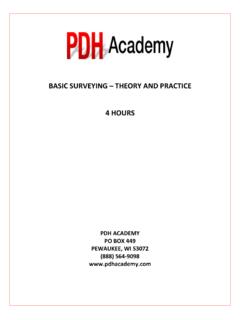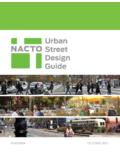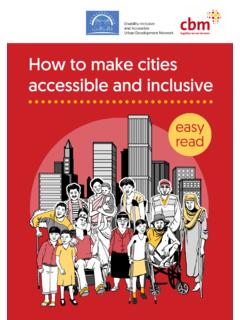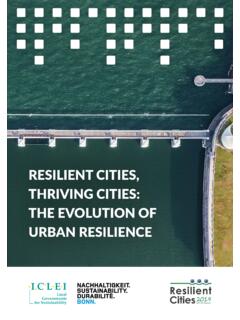Transcription of Urban Design for Architects: Space, Place, and Urban ...
1 Urban Design for Architects: Space, Place, and Urban Infrastructure PDH / 5 CE Hours / 5 AIA LU/HSW. PDH Academy PO Box 449. Pewaukee, WI 53072. 888-564-9098. Urban Design for Architects Final Exam 1. The most common types of development in 6. Traditional urbanism places emphasis on: American towns and cities between the years a. Social equity 1890 and 1930 were known as: b. The creation of Urban rooms . a. Garden cities c. Neo-classical style b. Radburn suburbs d. Vernacular aesthetics c. Greenbelt cities d. Streetcar suburbs 7. The primary strategy of contemporary Urban Design is to: 2. Pruitt-Igoe was regarded as a potent example of: a. Prioritize efficient movement of vehicles a. The International Style b. Assemble a series of unique buildings b. Pedestrian-friendly Design c. Create public spaces accessible to all c. Modernism's decline and fall d. Control building aesthetics d. The City Beautiful 8. Under ideal circumstances, nobody in an Urban 3.
2 The Weissenhof exhibition is known as a good community should be more than _____. example of: from some type of green / landscape space a. A classic garden suburb a. A five-minute drive b. Sensitive slum clearance b. A ten-minute drive c. The International Style c. A ten-minute bike ride d. The City Beautiful d. A five to ten-minute walk 4. Pedestrian Pockets were the precursor to: 9. The primary type of public space in America is: a. Traditional Neighborhood Development a. A plaza b. Dendritic Design b. A public park c. Transit-oriented Development c. A greenway d. The City of Tomorrow d. A street 5. The Charter of the New Urbanism sets out 10. Comparing the spaces of a city to the rooms of a beliefs about: house was first articulated by: a. Urban life, development and culture a. Vitruvius b. Building aesthetics b. Le Corbusier c. The importance of landscape in cities c. Leon Battista Alberti d. Le Corbusier's Design principles d. Andres Duany 4 | ARCHITECTURE.
3 CONTINUING EDUCATION. for Architects Urban Design For Architects: Space, Place, And Urban Infrastructure By David Walters RIBA. Professor Emeritus of Architecture and Urban Design Life takes place on foot. Jan Gehl, Life Between Buildings: Using Public Space AIA CES course number: AIAPDH147. COURSE DESCRIPTION. This course explains the origins of Urban Design theory and practice, from its roots in modernist architectural theory in the 1950s to present-day priorities of placemaking, combined with increasingly urgent concerns for sustainability and Urban resilience. Building from this conceptual foundation, the course teaches relevant techniques and processes used in the multi-disciplinary practice of Urban Design today. It charts the rejection of modernist concepts and the reengagement with principles of traditional urbanism and focuses on how buildings shape the public realm, relating both to the more intimate scale of Urban infill development and the larger scale of community master planning.
4 The course also introduces new skills required in Urban Design practice the art of coding the DNA of these master plans into zoning documents called Form-based Codes that can orchestrate the implementation of the master plan over an extended period of time. The course demonstrates how to identify and define contextual influences, how to master techniques for the effective Design of public space and infrastructure, and how to integrate these factors into the Design process. This enriched approach to architectural Design provides the platform for an architecture that is fully engaged with the life and rhythms of cities , communities and neighborhoods, and contributes to our shared task of creating sustainable and resilient cities . ARCHITECTURE Urban Design for Architects | 1. UNIT 1: environmental responsibility, social equity and economic viability, for example into the creation The Origins of Contemporary of places of beauty and distinct identity.
5 Urban Urban Design Theory and Practice. Design is derived from but transcends related matters such as planning and transportation policy, LEARNING OBJECTIVE 1. architectural Design , development economics, The student will understand that the Design ideas landscape [ Design ] and engineering. [It] is about common to the modernist period of city Design , creating a vision for an area and then deploying the loosely defined as the decades between 1950 and 1980, skills and resources to realize that vision (Llewelyn- were based on rejecting the patterns and relationships Davies, 2000: 12). in traditional cities and replacing them with radical re- imaginings of cities in a brave new world. Although these are English definitions, they apply equally to American practice, continuing the LEARNING OBJECTIVE 2 intertwining of Anglo-American Urban Design theory The student will build on this background and and practice that has typified the discipline for the past understand how these modernist ideas were supplanted 150 years.
6 By a return to more historically based and contextually driven responses which embrace principles of here follows an edited history of Urban Design traditional urbanism. in the United States, including the relevant cross- references in Europe that have shaped this country's practice. CONTENT. Introduction The Evolution of Urban Design in America The Evolution of Urban Design in America (circa 1860 the Present). (1850 the Present). While the Design of cities has been practiced for The Shifting Landscape of Urban Design millennia in different cultures, the term Urban Design . Theory and Practice as we understand it today in the 21st century was first coined in America during the 1950s. In 1956, Jos Luis The Rise and Fall of Modernist Urban Design Sert, Dean of Harvard's Graduate School of Design and Architectural Theory Meets Zoning Practice a pupil of modernist master architect and urbanist Le Corbusier, convened the first Urban Design Conference The Revival of Traditional Urbanism at Harvard and set up the first American Urban Design and the Birth of New Urbanism program at that university (Shane: 63).
7 One year later, in 1957, the American Institute of Architects set up a committee on Urban Design (Rowley: 306). Other Introduction versions of the profession's origins note the University First things first: let's not assume that we all share of Pennsylvania's Civic Design Program begun in 1957, the same definition(s) of Urban Design . After all, the and place the date of Harvard's Urban Design program discipline has undergone many changes since it was at 1960 (Barnett, 1982: 13). founded in our modern era as part of architecture's All three accounts of this subject's evolution oddly embrace of the city as a site for Design practice and omit mention of the founding of the very first theoretical discourse. In this first unit, we will briefly Department of Civic Design at the University of review the nineteenth century origins of Urban Design Liverpool in England half a century earlier in 1909. in the modern age, and explain its main concepts This historical oversight is surprising, especially as the as they changed through the middle decades of the theory and practice of city Design in the and the twentieth century.
8 We will then examine how this followed very similar and overlapping trajectories panoply of ideas about cities underwent a series of in the late nineteenth and early twentieth centuries. transformations and recapitulations to become the ideas that define Urban Design practice today, in the Indeed American urbanists consciously followed, second decade of the 21st century. and quite often improved on English precedent. This can be seen, for example, in comparisons between The term Urban Design as used in this course draws the designs for new communities: Victoria Park, on these historical precedents, but also includes more Manchester ( ) by Joseph Paxton (1837); Riverside recent understandings of environmental issues and outside Chicago (1869) by Frederick Law Olmsted and the social dynamics of places. In straightforward Calvert Vaux; Letchworth Garden City (1903) and terms, Urban Design means the art of making places Hampstead Garden Suburb in London (1907) both by for people (DETR, 2000, 93).
9 More specifically, Urban Barry Parker and Raymond Unwin, and Forest Hills Design Gardens, New York (1911), by Grover Atterbury and ..draws together the many strands of place-making Frederick Law Olmsted Jr. Other examples make this 2 | Urban Design for Architects ARCHITECTURE. transatlantic correspondence very clear, with influences from the 1890s to the 1930s proved to be the heyday and precedents flowing both ways. This period of for this type of Urban development. Urban development up through the late 1920s has left At the beginning of the twentieth century in America a legacy of sophisticated streetcar suburbs in cities the City Beautiful movement provided a grand, neo- and towns across the United States. These so-called classical vision of civic Design that further informed traditional neighborhoods derive their name from the status of civic space and civic architecture at the their use of historical types of clearly defined public heart of communities.
10 Meanwhile in Britain, Raymond infrastructure -- connected streets, short blocks, Unwin's massive tome Town Planning in Practice (1909). civic squares, plazas, parks, and alleys and by the way became a seminal text that wove all these strands these spaces are woven together to create the fabric of together into a rich historical, theoretical and practical everyday residential and commercial life. manual for designers of that period. This book is back The ideas upon which current Urban Design is in print and still contains a wealth of useful knowledge based today have direct connections back to these for today's Urban designer. concepts of traditional urbanism that were taught and A good example of this kind of development can be practiced a century ago. However, what makes the found at Forest Hills Gardens in Queens, New York, historical narrative confusing is that these ideas ones designed as a model town in 1909 by architect that shaped American cities in the decades of the late Grosvenor Atterbury and landscape architect Frederick 19th and early 20th centuries -- were soundly rejected, Law Olmsted Jr.
